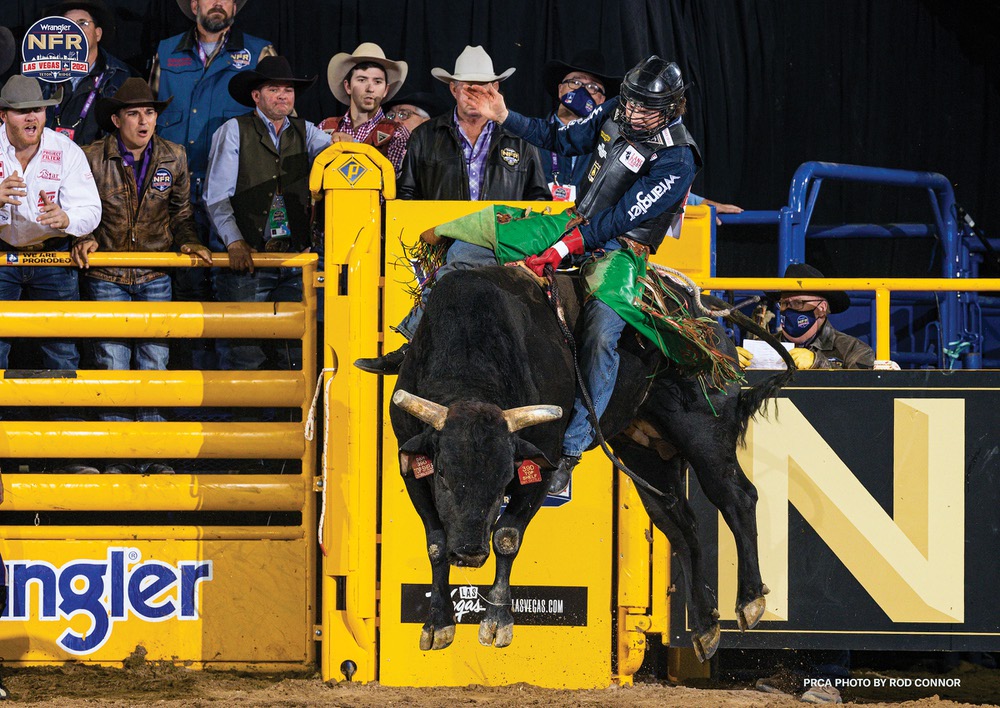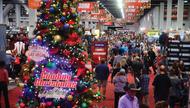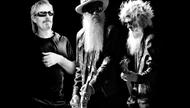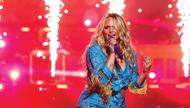Bull riders usually go until their mid-30s before calling it a career. Between the physicality of being flung into the air by a bull and the thousands of miles of travel, it can take a real toll on those who compete in the sport.
At age 27, Josh Frost says he still has plenty “left in the tank.”
NFR Week in Vegas
- Las Vegas Strip resident Miranda Lambert takes pride in her music and her platform
- National Finals Rodeo Week country concerts and comedy shows in Las Vegas
- No. 2 ranked bull rider Josh Frost returns to the scene of his 2021 National Finals Rodeo title
- NFR’s Cowboy Christmas brings shoppers and vendors together again in Las Vegas
Frost, the No. 2 ranked bull rider in the world by the Professional Rodeo Cowboys Association, is hoping to build off a strong 2021. He took home a personal best $363,353 in prize money last year, second most in the world, and he won his first National Finals Rodeo title in bull riding, besting second-place finisher Parker Breding by more than 50 points.
Frost will look to add to his winning résumé when NFR returns to Thomas & Mack Center December 1-10. “This is what we work for all year long,” Frost tells the Weekly. “If you’re a rodeo cowboy, this is the goal, to go win a gold buckle.”
What’s the biggest challenge for a bull rider? The bull riding is dangerous, the risk of injury is greater. The biggest [challenge] is just staying on the bull for eight seconds.
Your father (Shane) and grandfather (Joe) were successful saddle bronc riders. Is that how you found your way into the sport? Primarily. Growing up, I just remember always wanting to be a bull rider, because that’s what my dad did. I remember seeing pictures of him on the wall. He was able to help me, but I did little league baseball, riding sheep and calves, just worked my way up the size of the animal. There’s a lot of opportunities in rodeo. College rodeo is a big deal, so rodeo paid for my college. Went to college for four years, and I kept thinking to myself, “At least if this doesn’t work out, I’ll have a degree.” Once I graduated college, I kept working at the bull riding. Now, I’m one of the best in the world.
At age 27, have you thought about how many years you might have left or what your end goal might be? I don’t really have a cap on it. I’d say 35 would roughly be my number, but that being said, there’s a guy who’s 48 years old [and he’s] one of the top guys in the world. I read a statistic the other day that 33 is the average age of retirement for rough stock athletes. I dang sure think I’ve got more in the tank left to give.
It’s one of those jobs you’ve got to love and crave it, because it is dangerous. You’ve got to be fully committed, and have to travel—a lot of travel and miles. We’ll be at one rodeo one night and five hours away the next night. I don’t know if it’s so much the bull riding people get tired of as much as miles between the events.
How much travel do you think you put in a year? It’s pretty realistic to put 70,000-80,000 miles on a vehicle throughout a year. The summer is our busy time, between July and August. I’ll probably get on 55 bulls in 60 days, all in a different town. We hit roughly 35 states a summer, I’d say.
So it must be nice to stay in Vegas for 10 straight days. That’s why Vegas is the goal. You’re there 10 days. [Plus,] we spend a lot of money making the money we do make during the regular season. It’s pretty cool to go to Vegas for 10 nights in a row and [compete] for roughly $28,000 a night.
The last census put the population of your hometown of Randlett, Utah, at 200 people. What was it like growing up in a small town like that? I’m 10 miles outside of Randlett, completely in the middle of nowhere. We’re about 30 minutes away from the nearest Walmart or gas station (laughs). But it was a good place to grow up if you wanted to be a bull rider. We had a bunch of cows, so there was always a lot of calves and bulls running around to ride. A pretty blessed lifestyle.
I’ve got to spend almost every day of my life growing up with my family, my dad, working with him. I’ve got two brothers and a sister. We’re a close family. I live a mile up the road from my dad, my older brother lives a half-mile from him. We still kind of got a family operation going on running cows and doing stuff.
How do you stay mentally prepared for the biggest event in your sport? There’s a lot of work and prep that goes into it. October and November are kind of the slow months, so I’ve only been to one rodeo in the last two months. Besides that, just been home preparing, getting on practice bulls, in the gym working out. Pretty much do everything in those two months to roll into Vegas at 100%.
What does a workout look like for you? I’ve got a gym built in my house. I have a personal trainer, Doug Champion, who works with a lot of bull riders. I do weekly phone calls to make sure everything looks good.
You just won your third-straight Linderman Award, a huge honor in bull riding. What does that mean to you? It’s probably one of the most prestigious awards. You have to compete at both ends of the arena, both rough stock and timed events. You have to have three events to qualify, one has to be on the opposite end of the arena. Most guys specialize in one event, and bull riding is my specialty, but I’ve spent a lot of time competing at the professional level in other events.
There’s 5,000 cowboys in the league, but there’s two or three guys that are skilled to qualify. Once you qualify, it comes down to who can win the most combined money in the three events. To qualify alone is a very prestigious skill set. To say I’ve won it three times is pretty cool.
Click HERE to subscribe for free to the Weekly Fix, the digital edition of Las Vegas Weekly! Stay up to date with the latest on Las Vegas concerts, shows, restaurants, bars and more, sent directly to your inbox!





